1992 VOLKSWAGEN CARAVELLE check engine
[x] Cancel search: check enginePage 108 of 164
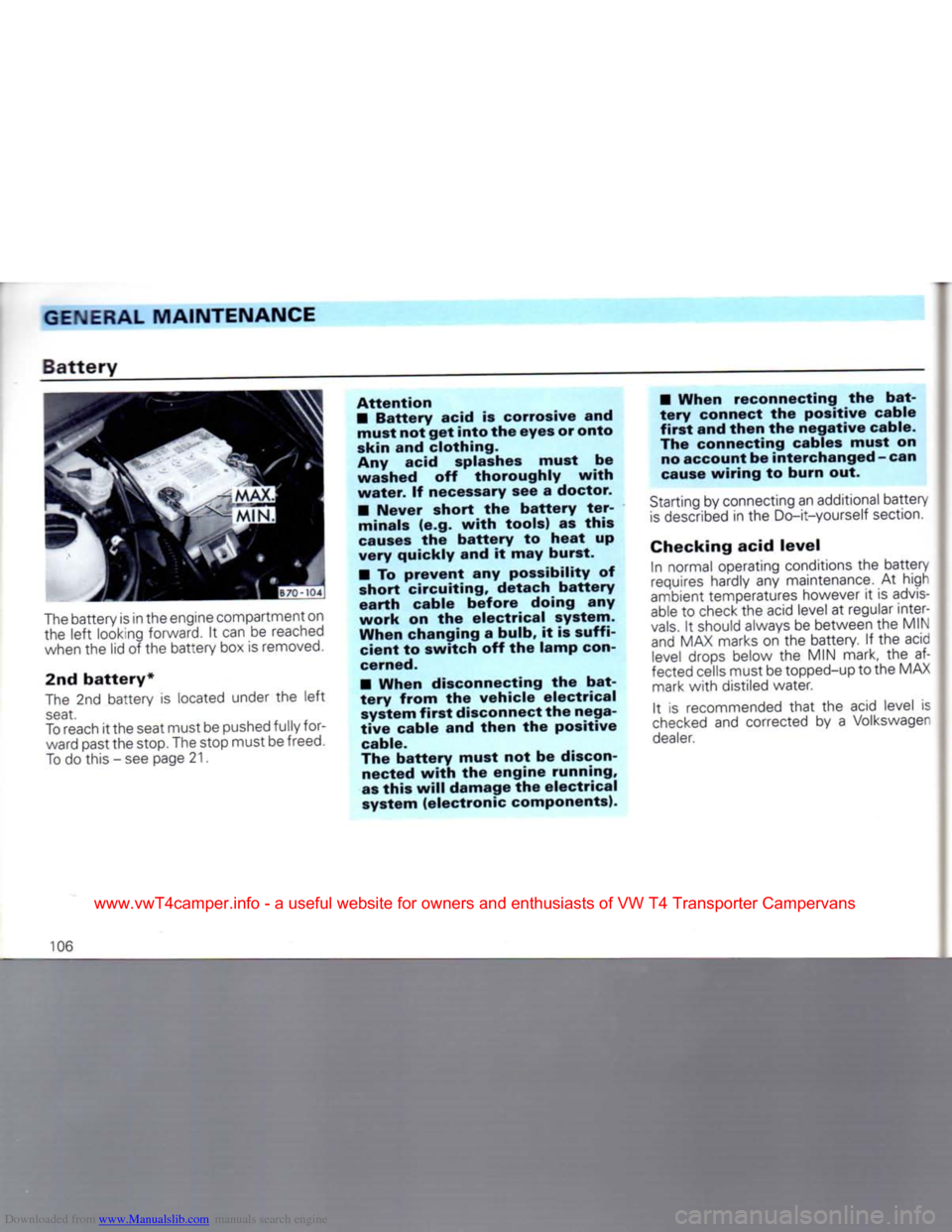
Downloaded from www.Manualslib.com manuals search engine
GENERAL
MAINTENANCE
Battery
The
battery is in the engine compartment on
the left looking forward. It can be
reached
when
the lid of the battery box is
removed.
2nd
battery*
The
2nd battery is located under the left
seat.
To
reach
it the
seat
must be
pushed
fully for
ward
past the stop. The stop must be
freed.
To
do this - see page 21. Attention
•
Battery
acid is corrosive and must not get
into
the eyes or onto
skin and clothing.
Any
acid splashes must be
washed off thoroughly
with
water.
If necessary see a doctor.
•
Never short the
battery
ter
minals (e.g.
with
tools) as this
causes
the
battery
to
heat
up
very quickly and it may burst.
•
To prevent any possibility of
short circuiting, detach
battery
earth
cable before doing any
work
on the electrical system.
When changing a bulb, it is sufficient to switch off the lamp
con
cerned.
•
When disconnecting the
bat
tery
from the vehicle electrical system
first
disconnect the nega
tive
cable and
then
the positive cable.
The
battery
must not be discon nected
with
the engine running,
as this
will
damage the electrical
system (electronic components).
•
When reconnecting the
bat
tery
connect the positive cable
first
and
then
the negative cable.
The connecting cables must on no account be interchanged - can
cause
wiring
to burn out.
Starting
by
connecting
an additional battery
is
described
in the Do-it-yourself
section.
Checking
acid level In normal operating conditions the battery
requires
hardly any maintenance. At high
ambient
temperatures however it is
advis
able
to
check
the
acid
level at regular inter
vals.
It should always be between the MIN
and
MAX marks on the battery. If the
acid
level
drops below the MIN mark, the af
fected
cells
must be topped-up to the MAX
mark
with distiled water.
It is recommended that the
acid
level is
checked
and corrected by a
Volkswager
dealer.
106
www.vwT4camper.info - a useful website for owners and enthusiasts of VW T4 Transporter Campervans
Page 109 of 164
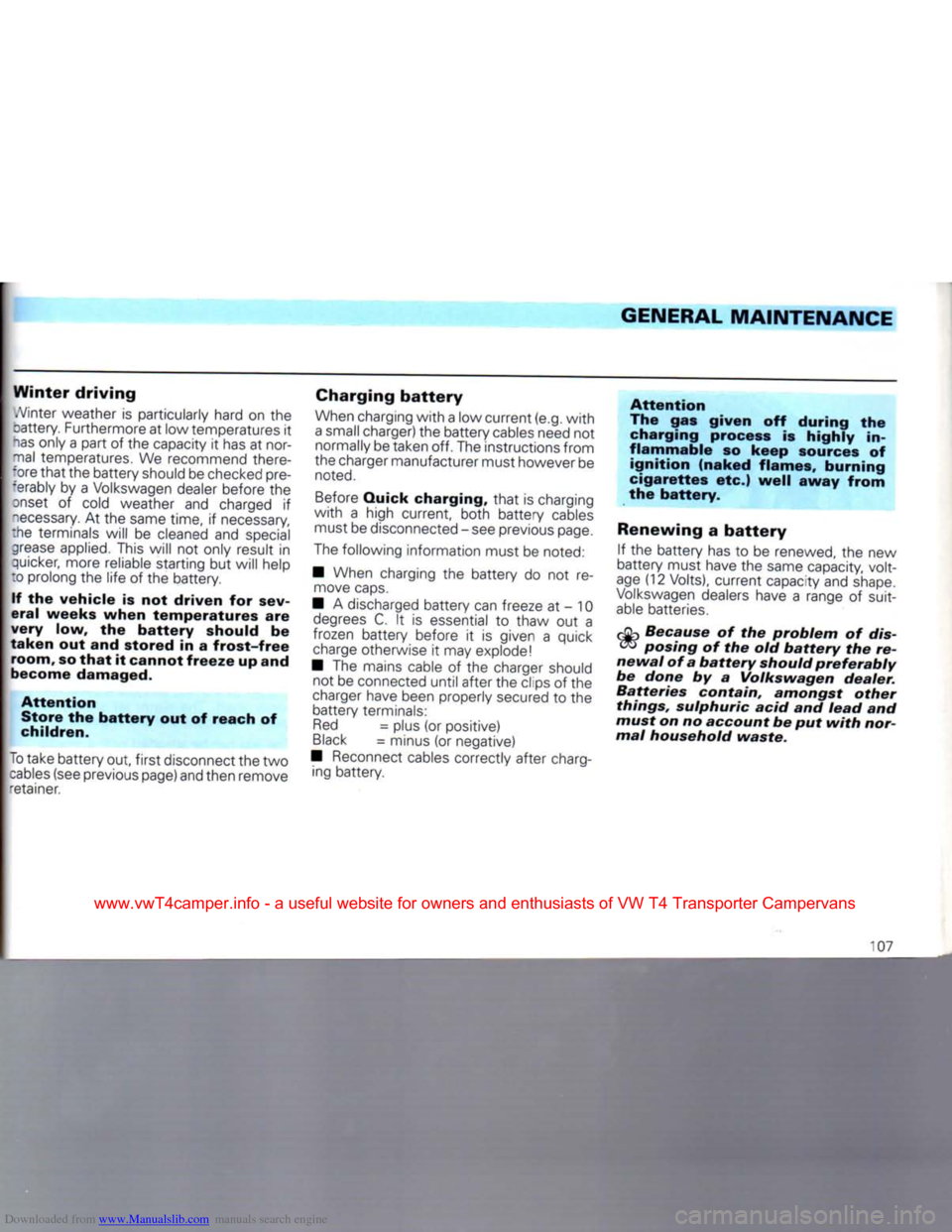
Downloaded from www.Manualslib.com manuals search engine
GENERAL
MAINTENANCE
Winter
driving
A/inter weather
is
particularly hard
on the
cattery. Furthermore at low temperatures
it
has
only a part
of
the capacity
it
has
at
nor mal temperatures.
We
recommend there-
-'ore
that
the battery should be checked pre
ferably
by a
Volkswagen dealer before
the
onset
of
cold weather
and
charged
if
"ecessary.
At
the same time,
if
necessary,
the terminals will
be
cleaned
and
special
grease
applied. This will
not
only result
in
quicker, more reliable starting but will help
:o prolong the life
of
the battery.
If the
vehicle
is not
driven
for
sev
eral
weeks
when
temperatures
are
very
low, the
battery
should
be
taken
out
and
stored
in a
frost-free
room, so
that
it
cannot
freeze
up and
become damaged.
Attention
Store
the
battery
out of
reach
of
children.
To
take battery out,
first
disconnect the two
cables
(see previous page) and then remove
-etainer.
Charging
battery
When
charging
with
a low current (e.g.
with
a
small charger) the battery cables need not normally be taken off. The instructions from
the charger manufacturer must however be
noted.
Before
Quick charging,
that
is
charging
with
a
high current, both battery cables must be disconnected
-
see previous page.
The
following information must be noted:
• When charging
the
battery
do not re
move
caps.
•
A
discharged battery can freeze
at - 10
degrees
C. It is
essential
to
thaw
out a
frozen battery before
it is
given
a
quick
charge
otherwise
it
may explode!
• The mains cable
of the
charger should not be connected until after the clips
of
the
charger
have been properly secured
to the
battery terminals:
Red
=
plus
(or
positive)
Black
=
minus
(or
negative)
• Reconnect cables correctly after charg ing battery.
Attention
The
gas
given
off
during
the
charging process
is
highly
in
flammable
so
keep
sources
of
ignition
(naked
flames,
burning
cigarettes
etc.)
well
away
from
the
battery.
Renewing
a battery If the
battery has
to be
renewed,
the
new
battery must have the same capacity, volt
age
(12 Volts), current capacity and shape.
Volkswagen
dealers have
a
range
of
suit
able
batteries.
Because
of the
problem
of
dis
posing
of
the
old
battery
the re
newal
of
a
battery
should
preferably
be
done
by a
Volkswagen
dealer.
Batteries
contain,
amongst
other
things,
sulphuric
acid
and
lead
and
must
on no
account
be put
with
nor
mal
household
waste.
107
www.vwT4camper.info - a useful website for owners and enthusiasts of VW T4 Transporter Campervans
Page 110 of 164
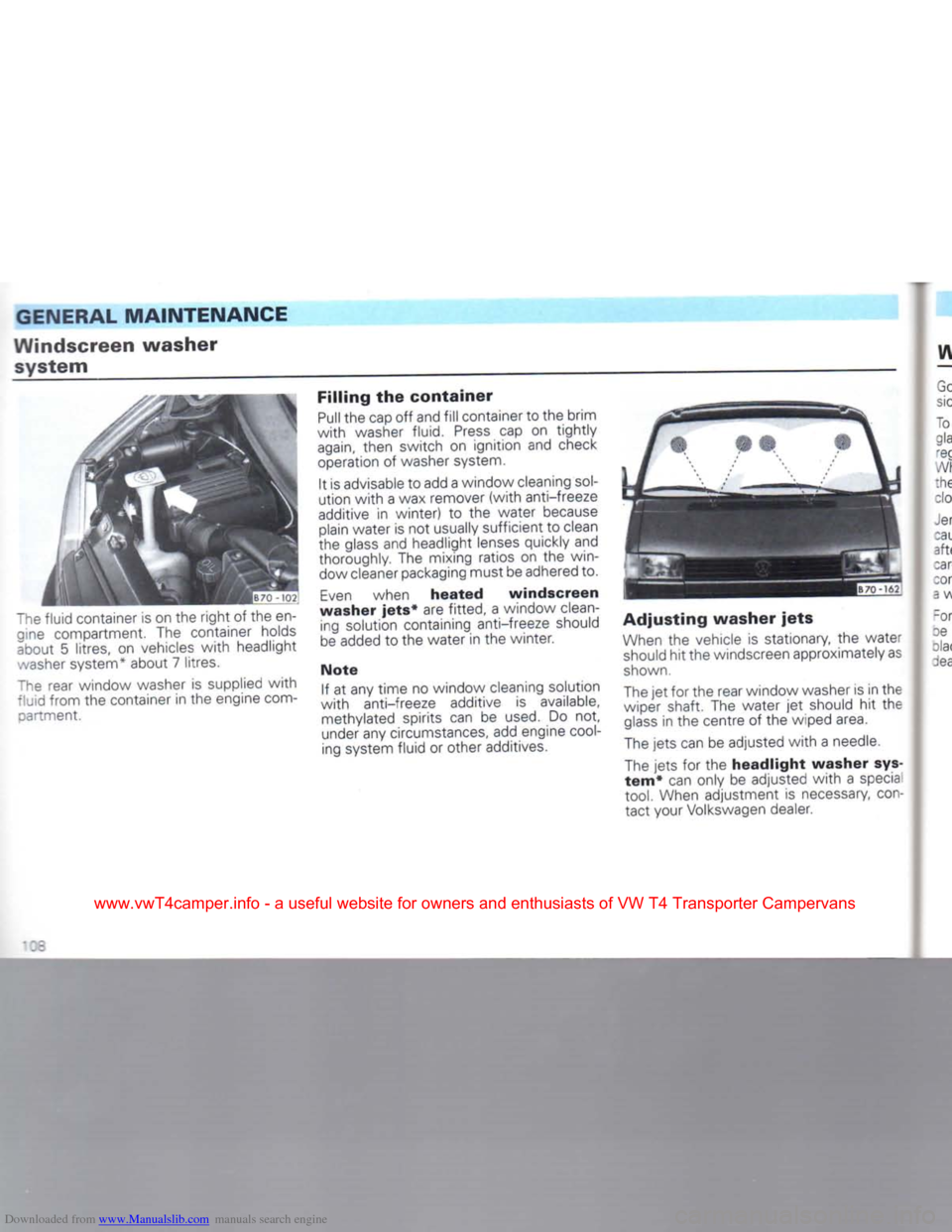
Downloaded from www.Manualslib.com manuals search engine
GENERAL
MAINTENANCE
Windscreen
washer
system
"he fluid container is on the
right
of the en gine compartment. The container holds
about 5 litres, on vehicles
with
headlight
washer
system* about 7 litres.
The
rear window washer is supplied
with
fluid from the container in the engine com-oartment. Filling the
container
Pull
the cap off and
fill
container to the brim
with
washer fluid.
Press
cap on
tightly
again,
then switch on ignition and check
operation of washer system.
It is advisable to add a window cleaning
sol
ution
with
a wax remover
(with
anti-freeze
additive in winter) to the water because plain water is not usually sufficient to clean
the glass and headlight lenses quickly and
thoroughly. The mixing ratios on the win dow cleaner packaging must be adhered to.
Even
when
heated
windscreen
washer
jets*
are fitted, a window clean ing solution containing anti-freeze should
be
added to the water in the winter.
Note
If at any time no window cleaning solution
with
anti-freeze additive is available, methylated spirits can be
used.
Do not,
under any circumstances, add engine
cool
ing system fluid or other additives.
Adjusting
washer
jets
When
the vehicle is stationary, the water
should
hit the windscreen approximately as
shown.
The
jet for the rear window washer is in the
wiper shaft. The water jet should hit the
glass
in the centre of the wiped area.
The
jets can be adjusted
with
a needle.
The
jets for the
headlight
washer
sys
tem*
can only be adjusted
with
a specia
tool.
When adjustment is necessary,
con
tact your Volkswagen dealer.
:=
www.vwT4camper.info - a useful website for owners and enthusiasts of VW T4 Transporter Campervans
Page 112 of 164
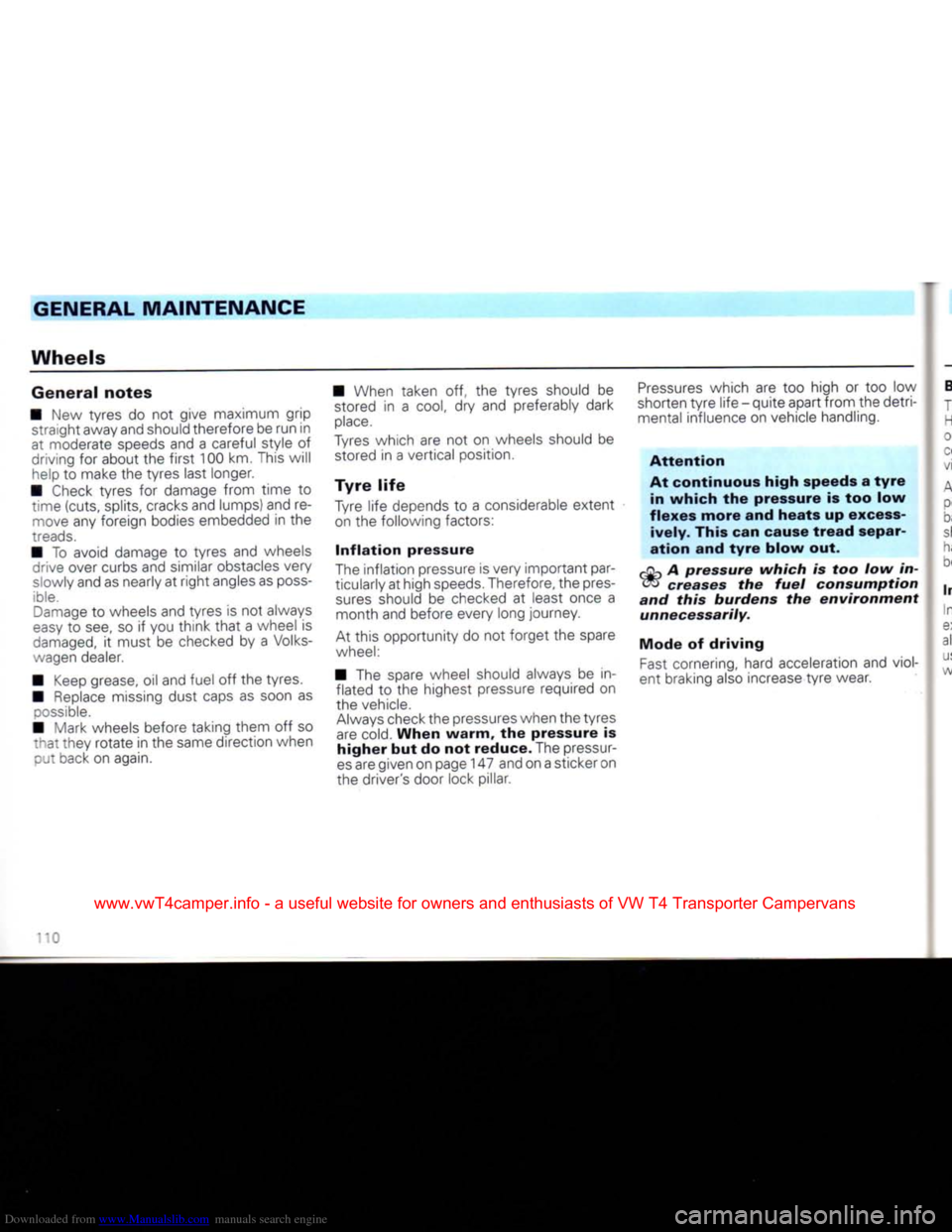
Downloaded from www.Manualslib.com manuals search engine
GENERAL
MAINTENANCE
Wheels
General
notes
• New tyres do not give maximum grip straight away and should therefore be run in
at moderate speeds and a careful style of
driving for about the
first
100 km. This will help to make the tyres last longer.
• Check tyres for damage from time to time (cuts, splits, cracks and lumps) and remove any foreign bodies embedded in the
treads.
• To avoid damage to tyres and wheels crive over curbs and similar obstacles very
slowly and as nearly at
right
angles as
poss
ible.
Damage
to wheels and tyres is not always
easy
to see, so if you
think
that
a wheel is
damaged,
it must be checked by a Volks
wagen dealer.
• Keep grease, oil and fuel off the tyres.
• Replace missing dust caps as soon as
possible.
• Mark wheels before taking them off so
that
they rotate in the same direction when put back on again. • When taken off, the tyres should be
stored in a
cool,
dry and preferably dark
place.
Tyres
which are not on wheels should be stored in a vertical position.
Tyre
life
Tyre life depends to a considerable extent on the following factors:
Inflation
pressure
The inflation pressure is very important par
ticularly at high
speeds.
Therefore, the pres
sures
should be checked at least once a month and before every long journey.
At this opportunity do not forget the spare
wheel:
• The spare wheel should always be in flated to the highest pressure required on
the vehicle.
Always
check the pressures when the tyres are cold.
When
warm,
the pressure is
higher
but do not
reduce.
The pressur
es
are given on page 147 and on a sticker on
the driver's door lock pillar.
Pressures
which are too high or too low
shorten
tyre
life - quite apart from the detri mental influence on vehicle handling.
Attention
At
continuous
high
speeds a
tyre
in
which
the pressure is too low
flexes
more
and
heats
up excess
ively.
This can cause
tread
separ
ation
and
tyre
blow
out.
pCU
A
pressure
which
is too low in- oo
creases
the
fuel
consumption
and
this
burdens
the
environment
unnecessarily.
Mode
of
driving
Fast
cornering, hard acceleration and viol
ent braking also increase
tyre
wear.
'0
www.vwT4camper.info - a useful website for owners and enthusiasts of VW T4 Transporter Campervans
Page 117 of 164
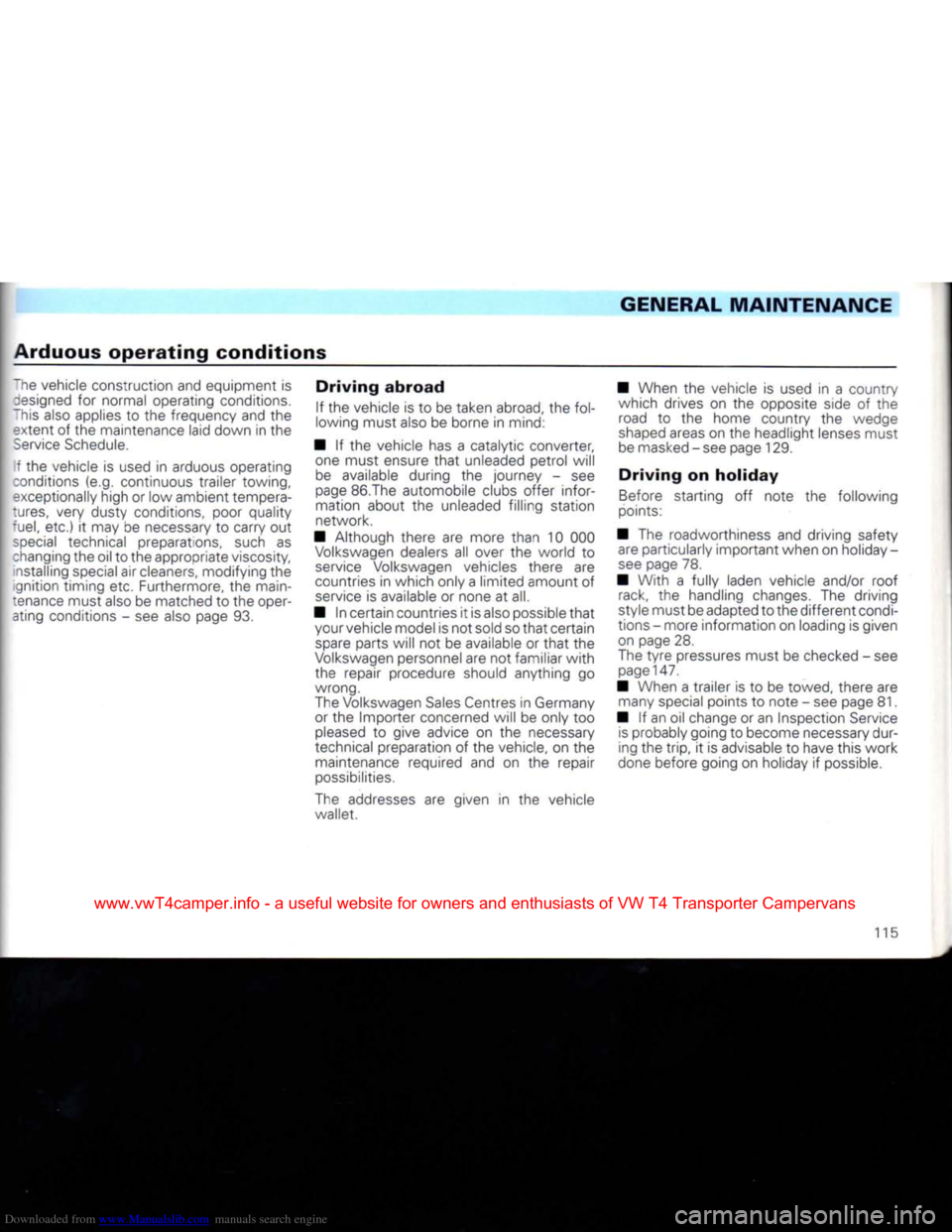
Downloaded from www.Manualslib.com manuals search engine
GENERAL
MAINTENANCE
Arduous
operating
conditions
ne vehicle construction and equipment is
resigned for normal operating conditions.
his also applies to the frequency and the
extent of the maintenance laid down in the
service
Schedule.
f the vehicle is used in arduous operating
conditions (e.g. continuous trailer towing,
exceptionally high or low ambient tempera-
:ures,
very dusty conditions, poor quality
ruel,
etc.) it may be necessary to carry out
special
technical preparations, such as ;hanging the oil to the appropriate viscosity, ^stalling special air cleaners, modifying the
ignition timing etc. Furthermore, the main
tenance must also be matched to the oper
ating conditions - see also page 93.
Driving
abroad
If the vehicle is to be taken abroad, the fol
lowing must also be borne in mind:
• If the vehicle has a catalytic converter, one must ensure
that
unleaded petrol will be available during the journey - see
page 86.The automobile clubs offer infor mation about the unleaded filling station
network.
• Although there are more than 10 000
Volkswagen
dealers all over the world to
service
Volkswagen vehicles there are
countries in which only a limited amount of
service
is available or none at all.
• In certain countries it is also possible
that
your vehicle model is not soid so
that
certain
spare
parts will not be available or
that
the
Volkswagen
personnel are not familiar
with
the repair procedure should anything go
wrong.
The Volkswagen
Sales
Centres in Germany or the
Importer
concerned will be only too
pleased
to give advice on the necessary
technical preparation of the vehicle, on the maintenance required and on the repair
possibilities.
The addresses are given in the vehicle wallet. • When the vehicle is used in a country
which drives on the opposite side of the road to the home country the wedge
shaped
areas on the headlight lenses must be masked - see page 129.
Driving
on
holiday
Before starting off note the following
points:
• The roadworthiness and driving safety are particularly important when on holiday-
see
page 78.
• With a fully laden vehicle and/or roof rack, the handling changes. The driving
style must be adapted to the different condi
tions - more information on loading is given
on page 28.
The
tyre
pressures must be checked - see
page147.
• When a trailer is to be towed, there are many special points to note - see page 81.
• If an oil change or an Inspection Service
is
probably going to become necessary dur
ing the
trip,
it is advisable to have this work
done before going on holiday if possible.
115
www.vwT4camper.info - a useful website for owners and enthusiasts of VW T4 Transporter Campervans
Page 118 of 164

Downloaded from www.Manualslib.com manuals search engine
GENERAL
MAINTENANCE
Winter
driving
T
Ac
The an«
safe
high
ensi
supf
with
poin
sub:
tech latei
• /
fori
any
thro
SWc
pete
A
In
m
s<
V
G
u
P
SI
a
s|
r<
In winter the following points should be
noted:
• Winter weather is particularly hard on the
battery
and it should therefore be
checked,
preferably by a Volkswagen
dealer, before the onset of cold weather. If the vehicle is not driven for several weeks
when the temperatures are very low, the
battery
should be taken out - for
further
in
formation see page 107.
• On a vehicle
with
a Diesel engine, winter
Diesel
must be used at temperatures below
0 degrees C - see page 87.
• The water should be drained out of the
Diesel
fuel
filter
before the onset of
winter.
This
operation is also included in the Lubri cation
Service.
• The anti-freeze in the cooling system should be checked before the cold
season
starts - see page 101.
• The engine oil viscosity must be correct for the ambient temperature - see page 99.
• Particularly in
winter,
frequent washing and waxing of the vehicle is the best way to protect it against harmful environmental in
fluences.
• In winter the windscreen washer
sys
tem should always be filled
with
a window
cleaning solution containing an anti-freeze
additive.
• To remove snow and ice
from
the win dows and mirrors, a plastic scraper should be used - see page 90.
• The road holding and handling can be im proved in winter road conditions by the use
of winter or All-weather tyres - see pages 114and146.
• When driving in mountainous districts in winter it is advisable to take snow chains
with
you. On some such roads, snow chains
are obligatory - see also page 114.
www.vwT4camper.info - a useful website for owners and enthusiasts of VW T4 Transporter Campervans
Page 123 of 164

Downloaded from www.Manualslib.com manuals search engine
DO-IT-YOURSELF
- Wind jack arm up by turning the crank handle
until
the jack
just
goes under the
vehicle.
- The claw of the jack must fit round the vertical rib on the side member so
that
the jack cannot slip when vehicle is
lifted
- see illustration.
- If the ground is soft, place a large strong
piece
of packing under the jack base
plate.
- Align jack and at same time wind claw up
further
until
it contacts the vertical rib on
side
member. •
Lift
vehicle
until
the defective wheel is
clear
of ground.
• Remove wheel bolts and place them on
a
clean surface (hub cap, cloth, paper) next
to the jack and take the wheel off.
• Fit spare wheel and lightly tighten all bolts. The wheel bolts must be clean and
easy
to
turn
- do not under any circum
stances
use grease or oil!
• Lowervehicleand fully tighten bolts indi- agonal sequence.
• Refit the wheel trim.
•
Place
defective wheel in spare wheel carrier and secure it - see page 119.
Notes
• Pay attention to the following after changing a wheel:
- Check the
tyre
pressure immediately on the spare wheel which has been fitted.
- Have the tightening torque of the wheel bolts checked
with
a torque wrench as
soon
as possible. The torque for steel
and alloy wheels is 160 Nm. If it has been established when changing
the wheel
that
wheel bolts are corroded and hard to screw in, they must be renewed be
fore checking the tightening torque.
Until these checks have been carried out
one should, for safety reasons, only drive at
a
moderate
speed.
• The defective wheel should be repaired
as
soon as possible.
Attention
If the
vehicle
is to be
subsequent
ly
fitted
with
wheels
or
tyres
which
differ
from
those
fitted
by
the
factory,
it is
essential
to
read
the
remarks
in the
centre
and
right
hand
columns on
page
113.
121
www.vwT4camper.info - a useful website for owners and enthusiasts of VW T4 Transporter Campervans
Page 124 of 164

Downloaded from www.Manualslib.com manuals search engine
DO-IT-YOURSELF
Fuses
The
individual current circuits are protected by fuses..
The
central electrics
with
the relays is on
the
left
in the footwell behind a hinged shelf. It is advisable to always carry a few spare
fuses
on the vehicle. These can be obtained
from any Volkswagen dealer. Changing a fuse
• Switch off the component concerned. • Take box or lid off by turning knob 90 de
grees
to
right
or
left,
then pull and unhook box or lid out of retainers at the bottom.
• With the aid of the list of fuses (see next
page),
determine which fuse belongs to the
component
that
has failed. • Pull out the fuse concerned.
• Replace blown fuse - can be recognised
by the burnt metal strip -
with
a fuse of
same
amperage.
• Insert box or lid by turning knob again
905
to
right
or
left,
hook box or lid on at bot
tom, swing up and press knob in.
Notes
• If the newly inserted fuse blows again after a short time, the electrical system must be checked by
a
Volkswagen dealer as
soon
as possible.
• On no account should fuses be
patched
up because
this
can cause
serious
damage
elsewhere
in the
electrical
system.
• Some of the components listed are only found on certain models or are optional ex
tras.
122
www.vwT4camper.info - a useful website for owners and enthusiasts of VW T4 Transporter Campervans